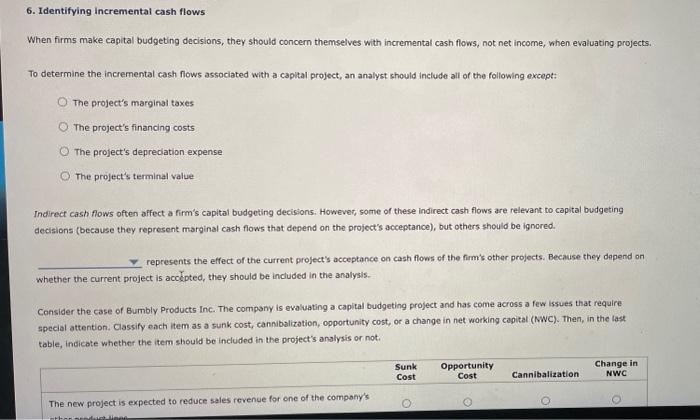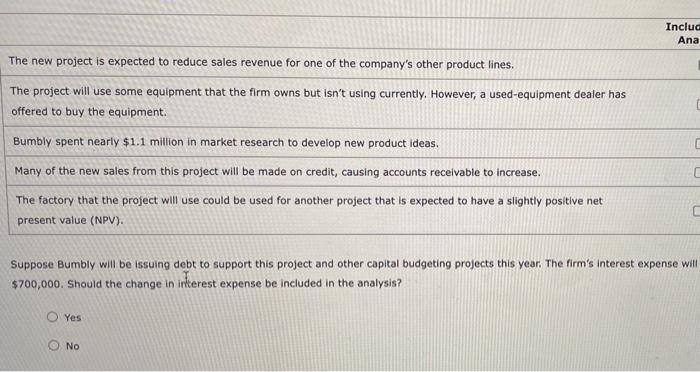6. Identifying incremental cash flows When firms make capital budgeting decislons, they should concern themselves with incremental cash flows, not net income, when evaluating projects. To determine the incremental cash flows associated with a capital project, an analyst should include all of the following except: The project's marginal taxes The project's financing costs The project's depredation expense The project's terminal value Indirect cash flows often affect a firm's capital budgeting decisions. However, some of these indirect cash flows are relevant to capital budgeting decisions (because they represent marginal cash flows that depend on the project's acceptance), but others should be ignored. represents the effect of the current project's acceptance on cash flows of the firm's other projects. Because they depend on whether the current project is accepted, they should be included in the analysis. Consider the case of Bumbly Products Inc. The company is evaluating a capital budgeting project and has come across a few issues that require special attention. Classify each item as a sunk cost, cannibalization, opportunity cost, or a change in net working copital (NwC). Then, in the last table, indicate whether the item should be included in the project's anslysis or not. The new project is expected to reduce sales revenue for one of the company's other product lines. The project will use some equipment that the firm owns but isn't using currently. However, a used-equipment dealer has offered to buy the equipment. Bumbly spent nearly $1.1 milion in market research to develop new product ideas. Many of the new sales from this project will be made on credit, causing accounts recelvable to increase. Include in the Analysis? The new project is expected to reduce sales revenue for one of the company's other product lines. The project will use some equipment that the firm owns but isn't using currently. However, a used-equipment dealer has offered to buy the equipment. Bumbly spent nearly $1.1 million in market research to develop new product ideas. Many of the new sales from this project will be made on credit, causing accounts recelvable to increase. The factory that the project will use could be used for another project that is expected to have a slightly positive net present value (NPV). The new project is expected to reduce sales revenue for one of the company's other product lines. The project will use some equipment that the firm owns but isn't using currently. However, a used-equipment dealer has offered to buy the equipment. Bumbly spent nearly $1.1 million in market research to develop new product ideas. Many of the new sales from this project will be made on credit, causing accounts receivable to increase. The factory that the project will use could be used for another project that is expected to have a slightly positive net present value (NPV). Suppose Bumbly will be issuing debt to support this project and other capital budgeting projects this year. The firm's interest expense will $700,000. Should the change in irterest expense be included in the analysis? Yes No









